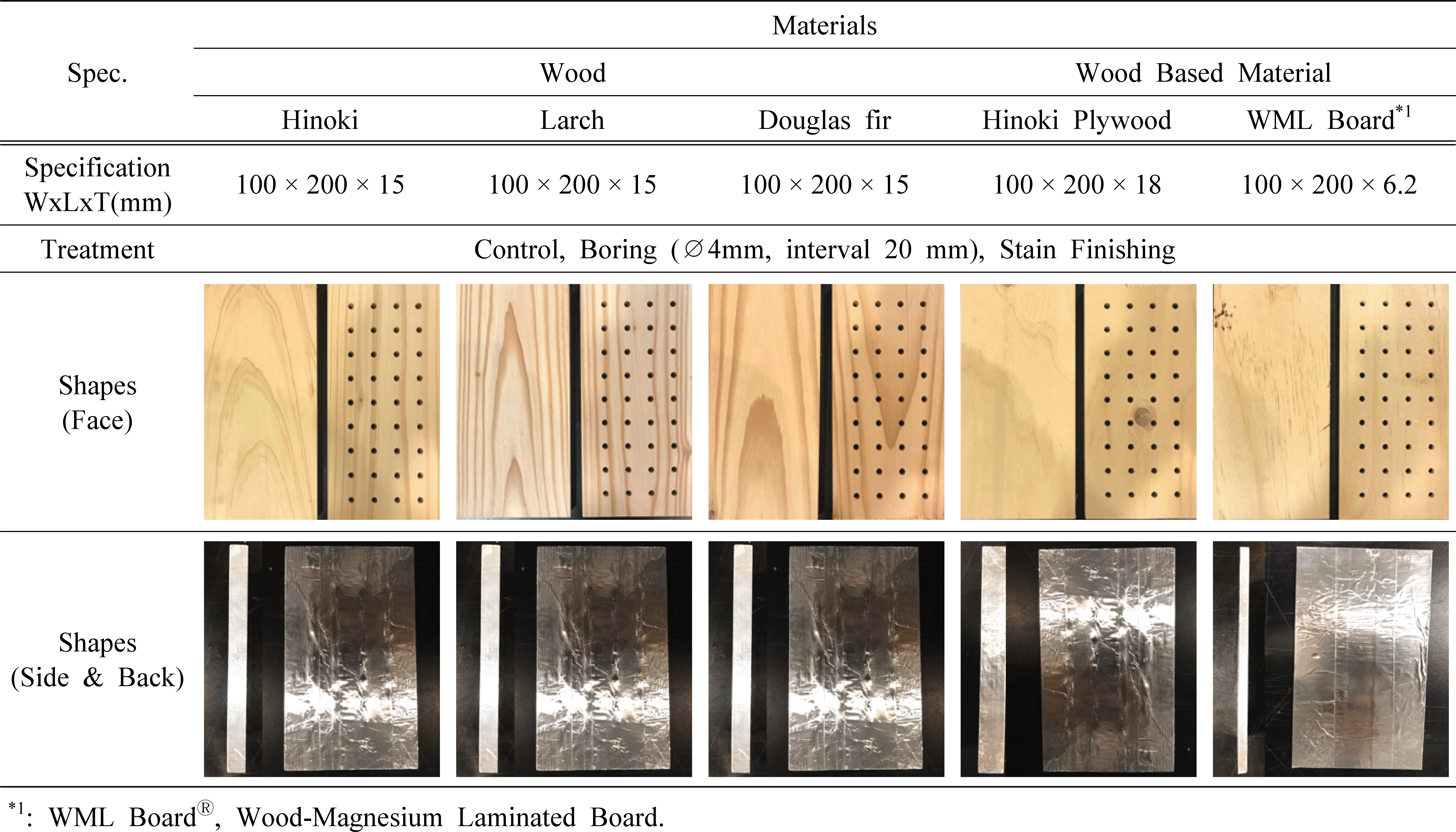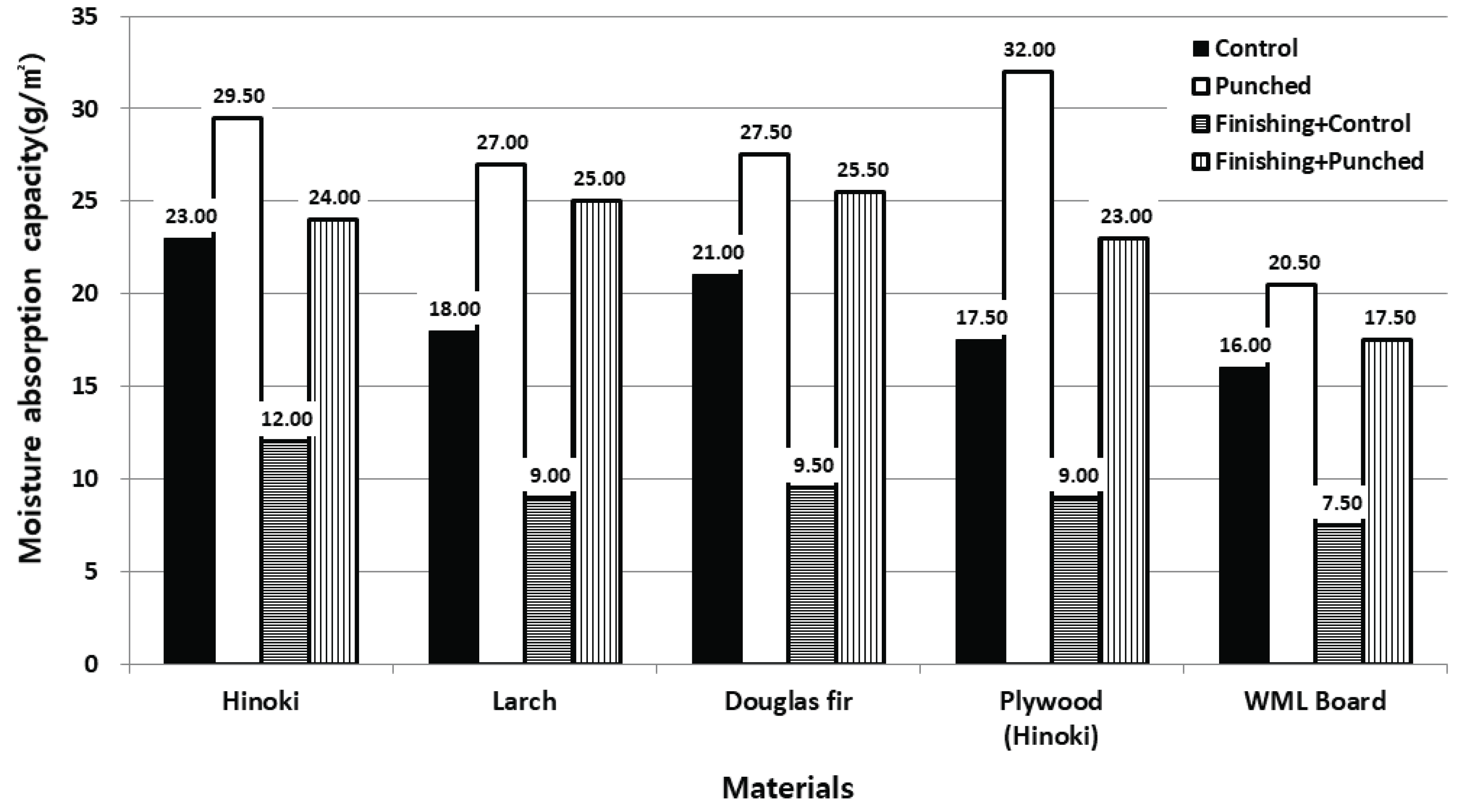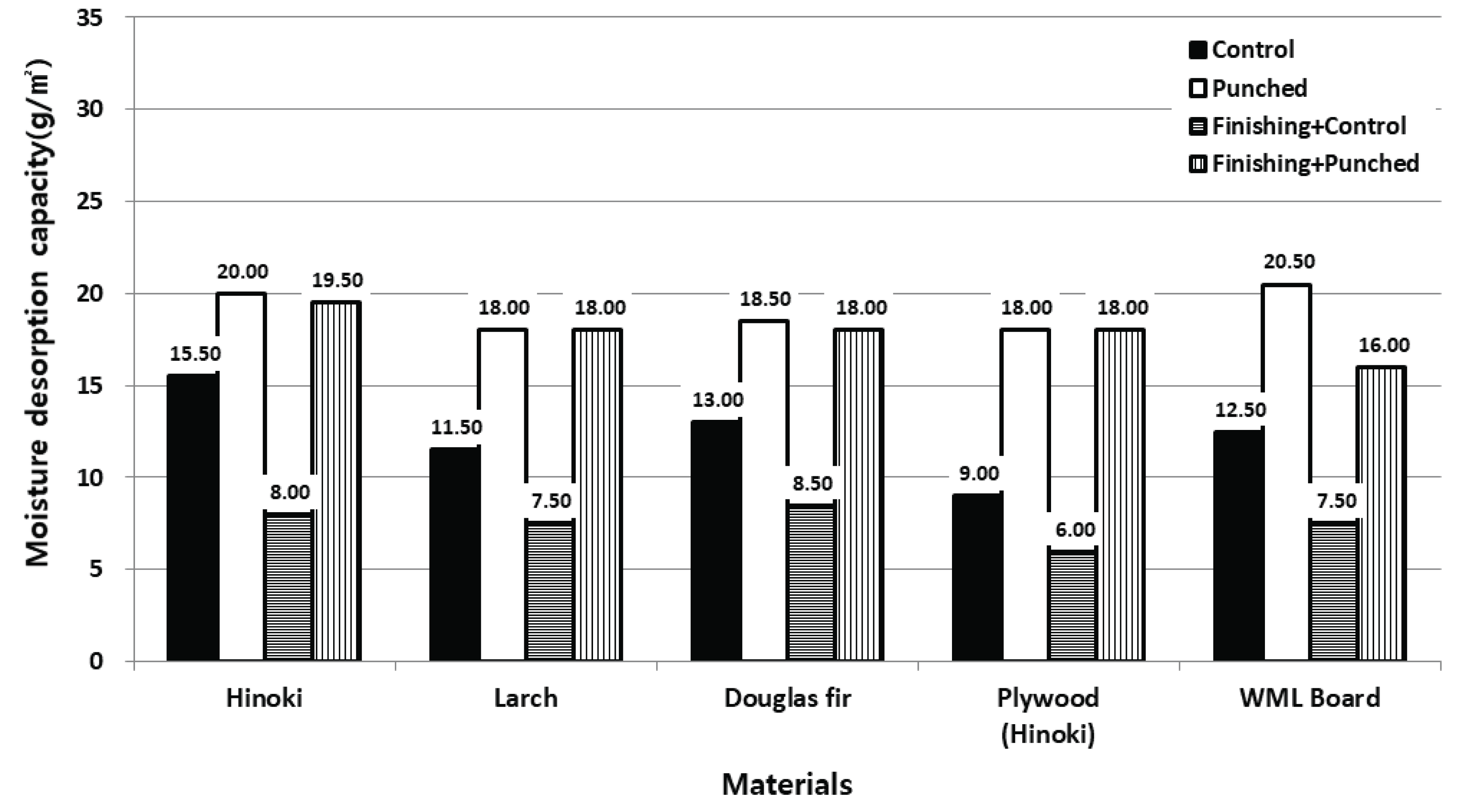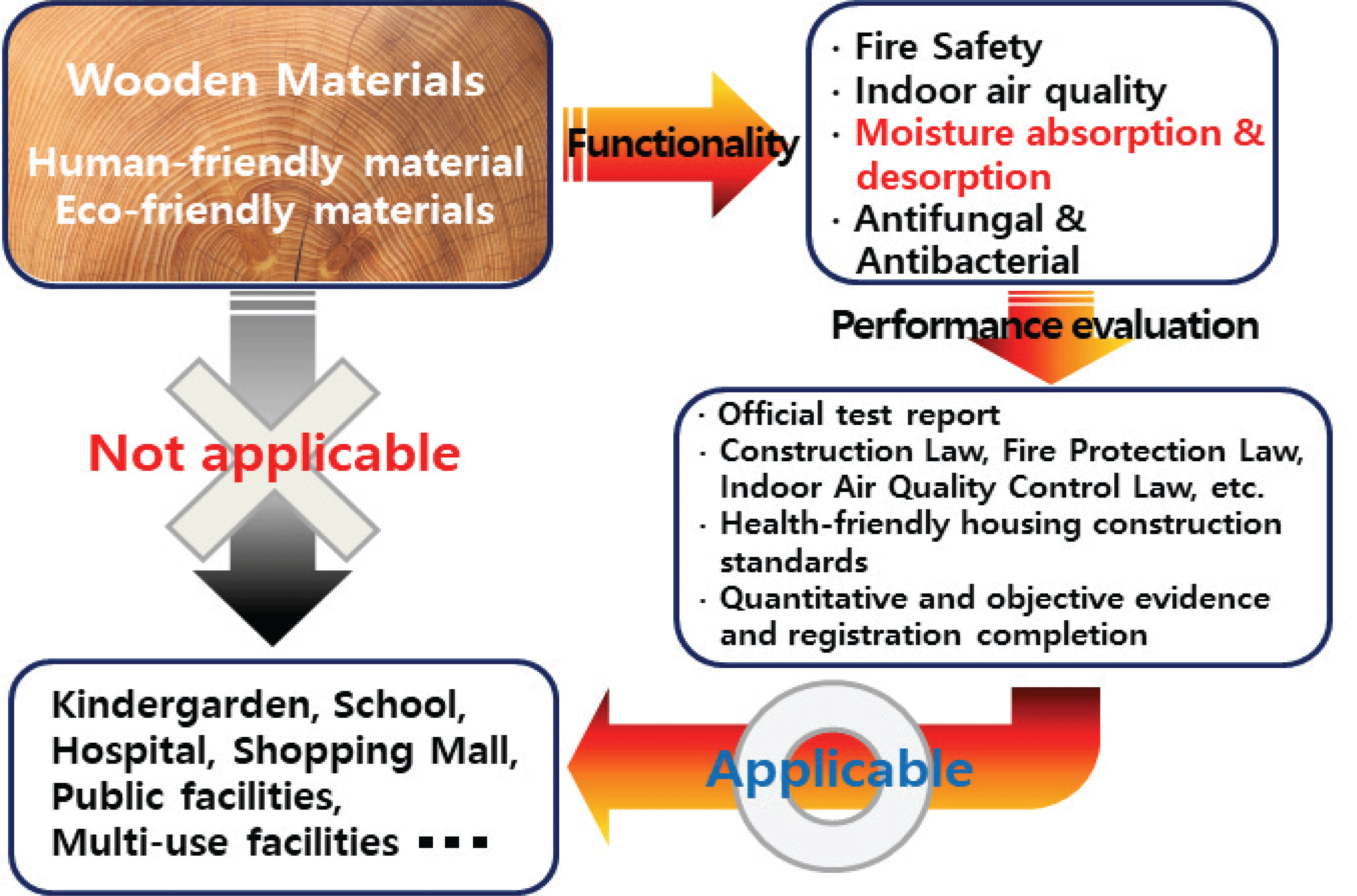1. INTRODUCTION
Comfortable indoor environments can be said to be one of the important factors that determine the health and quality of life of modern people, who spend most of the day (about 90%) indoors. Therefore, conventional dwellings, apartments, and business or commercial buildings are spaces where people reside or carry out a variety of activities, and various finishing materials are being developed in order to improve the environments where safe and comfortable lives can be led. However, most interior finishing materials still used widely are concrete, gypsum boards, synthetic resins, and ceramic products, which lead to high humidity in summer and low humidity in winter in areas where four seasons are clear, and become important causes of dew condensation and biological contamination, such as various kinds of viruses and fungi (Nielsen et al., 2004) that are identified to cause weakened immunity of the residents and diseases such as asthma, rhinitis, and bronchitis (Husman, 1996). In general, indoor environments where indoor temperatures of 18 ~ 20 °C and relative humidity of 40 ~ 70% are maintained are known to provide comfort, and it is known that viruses become active when the humidity is lower than the foregoing, while fungal reproduction becomes active when the humidity is higher than the foregoing (KWPRC, 2016). A study evaluated the sorption properties and antifungal performance of wallpaper to analyze the effect of the moisture sorption property of interior finishing materials on mold growth, and based on the results, the researchers reported close correlations between the moisture sorption property of wallpaper and mold germination/ growth rates (Moon et al., 2013).
Therefore, the importance of the safety of interior finishing materials and environments is emphasized more than ever before. Sick building syndrome (SBS), which adversely affects the health of residents due to indoor air pollutants, originates from construction materials, etc. applied to indoor spaces. A study conducted to secure proper indoor air quality evaluated the moisture adsorption and desorption performances of three types of ceramic panels and painting materials for humidity control, and the researchers reported that the ceramic panels did not meet the Health-Friendly Housing Construction Standards because the moisture desorption performance of the ceramic panels was 36.6g/m2, and it was lower compared to the moisture absorption performance, which was 73.3 g/m2 (Jang and Ryu, 2018).
Among the various finishing materials, wood is known to provide comfortable environments because the range of fluctuation of humidity is reduced when wood is used as finishing materials since wood continuously controls humidity until its moisture content becomes identical to the humidity of the surrounding environment by absorbing moisture when the humidity of the air is high and releasing the moisture when the humidity is low (KWPRC, 2016). Lee (1991) compared and studied the moisture absorption and desorption properties of the wood of five species. Studies have shown that the moisture absorption and desorption properties of wood were more strongly associated with tissue structures inherent in wood than with the specific gravity of wood and that the property of sorption was affected more by vapor pressure gradients than by temperatures.
In a study conducted to improve areas where moisture damage such as moisture absorption and dew condensation is a concern when wooden buildings are constructed, Lee et al. (2016) made carbonized boards using four kinds of wood-based materials (plywood, OSB, MDF, and PB) and compared the moisture absorption/ desorption properties of the carbonized boards. In a study conducted to develop moisture absorption/ desorption functional building materials, Jo et al. (2019) produced a wood-magnesium laminated composite material (WML Board), punched holes in the surface of the composite material in order to improve the humidity control effect, coated the back with a humidity control agent, and measured the amounts of moisture absorbed and desorbed. Based on the results, the researchers reported that the treated composite material could reach the average amounts of moisture absorbed and desorbed of 65 g/m2, which is the standard for moisture absorption/desorption functional building materials (Jo and Park, 2019).
The government revised the Health-Friendly Housing Construction Standards (Ministry of Land, Infrastructure and Transport, 2019) in 2019 to determine the performance standards for moisture absorption/desorption functional building materials as average amounts of moisture absorbed and desorbed, which are at least 65 g/m2, and made the standard mandatory. In addition, in the Green Technology provision determined by the Act on Low Carbon Green Growth, standards for functional building materials were newly established in relation to absorption/desorption technologies to designate materials with amounts of moisture absorbed/desorbed not less than 85 g/m2 as green technology products, and the standards have been operated.
This is a basic study conducted to develop building finishing materials that meet the standards for moisture absorption and desorption as defined by the Health-Friendly Housing Construction Standards (Ministry of Land, Infrastructure and Transport, 2019). One cycle of moisture absorption and desorption tests was conducted with wood of three tree species (hinoki, larch, and Douglas fir) and two types of wood-based materials (hinoki plywood and wood-magnesium laminated board) without any treatment, with surface punching, and with surface stain finishing. In general, wood and wood-based materials are eco-friendly materials and are known to have excellent humidity control functions, but they cannot be easily applied as building finishing materials in cases where they do not meet the Health-Friendly Housing Construction Standards. Therefore, in this study, the moisture absorption and desorption properties of materials with different physical processing treatments were compared and evaluated according to Korean Industrial Standard KS F 2611, Hygrothermal performance of building materials and products-Determination of moisture adsorption/ desorption properties in response to humidity variation. This study is intended to develop physical and chemical treatment methods suitable for the Criteria for Functional Building Materials with improved moisture absorption and absorption performance hereafter.
2. MATERIALS and METHODS
The wood used for the evaluation of moisture absorption and desorption properties came from three tree species: hinoki (Chamaecyparis obtusa (Siebold & Zucc.) Endl.), larch (Larix kaempferi (Lamb.) Carriè re), and Douglas fir (Pseudotsuga menziesii). Specimens of each tree species were tested according to KS F 2611, Hygrothermal performance of building materials and products-Determination of moisture adsorption/ desorption properties in response to humidity variation, after reaching constant weights in a thermo- hygrostat at a temperature of 23 ± 0.5 °C and relative humidity of 30 ± 1% (EMC≒6.0%) in accordance with KS F 2611. The shapes of the materials used in this study are as shown in Table 1.
Two types of wood-based materials were used for the evaluation of moisture absorption and desorption properties: 18 mm thick hinoki plywood and 6.2 mm thick wood-magnesium laminated board (WML Board®) made by bonding 1.6 mm thick radiata pine veneers on both sides of a 3.0 mm thick magnesium board. According to KS F 2611, specimens of each material were tested after reaching constant weights in a thermo- hygrostat at a temperature of 23 ± 0.5 °C and relative humidity of 30 ± 1 %. The specifications and shapes of the materials used in this study are as shown in Table 1.
In this study, wood of three tree species and two types of wood-based materials with no treatment (control), with punching, and with stain finishing as shown in Table 1 were tested to evaluate whether they meet the amounts of moisture absorbed and desorbed set forth under the Health-Friendly Housing Construction Standards. In general, wood finishing materials are painted on the surface with various kinds of paint before or after construction to protect the surface and improve the dimensional stability. Although painting is effective in improving the dimensional stability of wood, it is judged to adversely affect the moisture absorption and desorption of finishing materials. Therefore, the surfaces of the finishing materials were punched to increase the surface area of the cross-section of the wood and evaluate the effect of punching to improve moisture absorption and desorption properties. As shown in Table 1, ∅4mm holes were punched at 20 mm intervals.
The stain used for surface finishing was “Crack Seal Wood” manufactured by Dongwha Industrial Co. The test specimens were coated with 100 g/m2 of Crack Seal Wood and tested after reaching constant weights in a thermo-hygrostat at a temperature of 23 ± 0.5 °C and relative humidity of 30 ± 1%. The amounts of moisture absorption and desorption of two test specimens each with no treatment (control), with punching, and with stain finishing of wood of three species and two types of wood-based materials, that is, a total of 40 test specimens were measured.
In this study, wood of three tree species and two types of wood-based materials with no treatment (control), with punching, and with stain finishing as shown in Fig. 1 were tested according to KS F 2611: 2009. First, test specimens were conditioned to reach constant weights in a thermo-hygrostat at a temperature of 23 ± 0.5 °C and relative humidity of 30±1% and were moisture blocking treated with aluminum tape on all surfaces except for the moisture absorption and desorption surface.
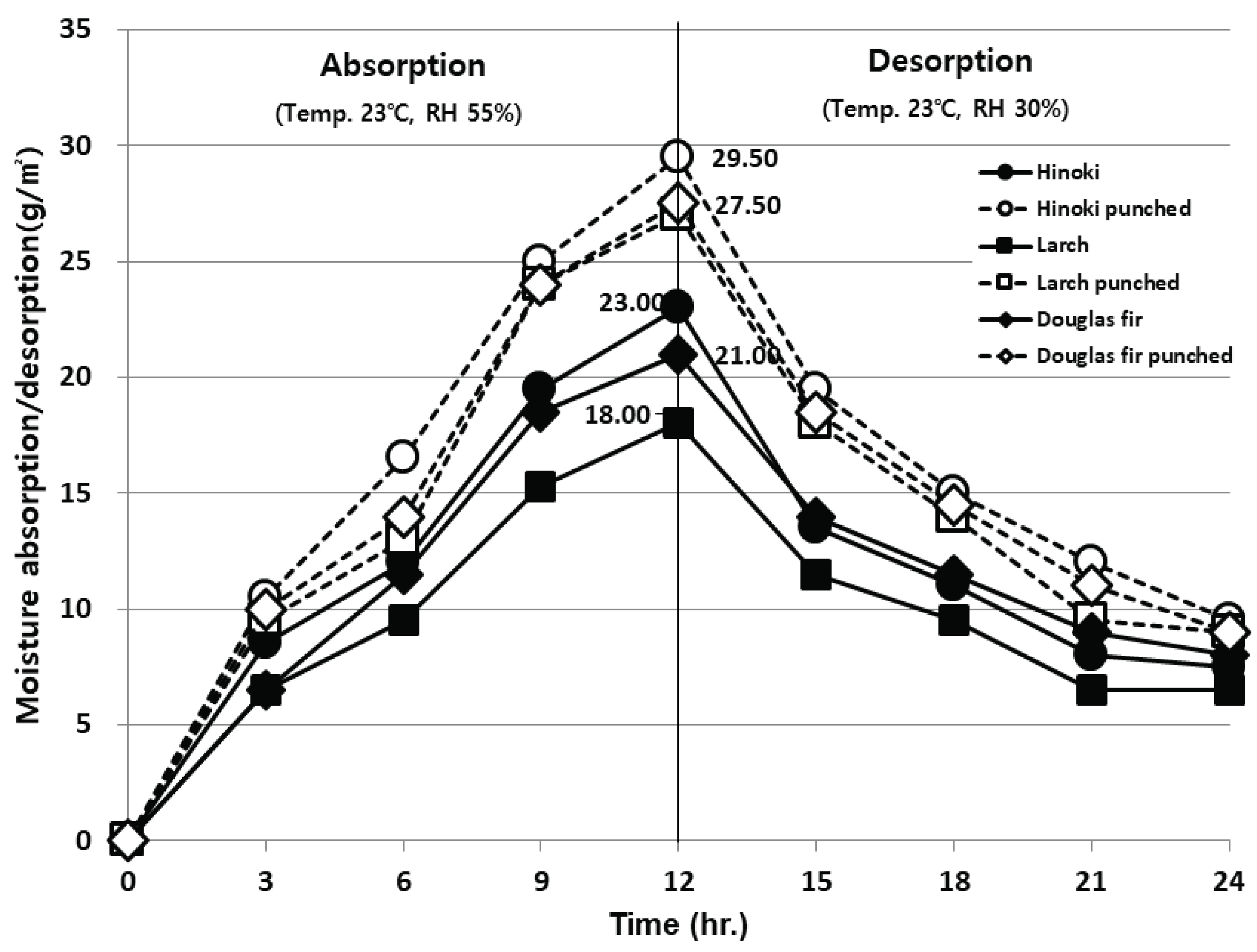
The test was conducted under the conditions as shown in Table 2 for a total of 24 hours through a moisture absorption process (step 1) at a temperature of 23 ± 0.5 °C and relative humidity of 55 ± 1% for 12 hours followed by a moisture desorption process (step 2) at a temperature of 23 ± 0.5 °C and relative humidity of 30 ± 1% for 12 hours.
Changes in the amounts of moisture absorbed and desorbed were identified by measuring the weights of test specimens after reaching constant weights under the preconditioning conditions (23 ± 0.5 °C and 30 ± 1% RH) and measuring the weights thereafter at intervals of three hours during the period of moisture absorption and desorption. The measured weights were then compared and evaluated by material and by treatment. In addition, the results of measurement were evaluated to see whether they meet or can meet the criteria for moisture absorption and desorption functional building materials set forth under the Health- Friendly Housing Construction Standards (Ministry of Land, Infrastructure and Transport, 2019).
3. RESULTS and DISCUSSION
After humidifying wood from three tree species (hinoki, larch, Douglas fir) and two types of woodbased materials (plywood, WML Board) with no treatment (control), punching, and stain finishing at a temperature of 23 °C and relative humidity of 30%, the moisture absorption and desorption properties of the materials were evaluated with a stage 1 moisture absorption process (12 hr.) and stage 2 moisture desorption process (12 hr.). Changes in the amounts of moisture absorbed and desorbed over time are as shown in Tables 3 and 4, and Figs. 1, 2, 3, and 4.
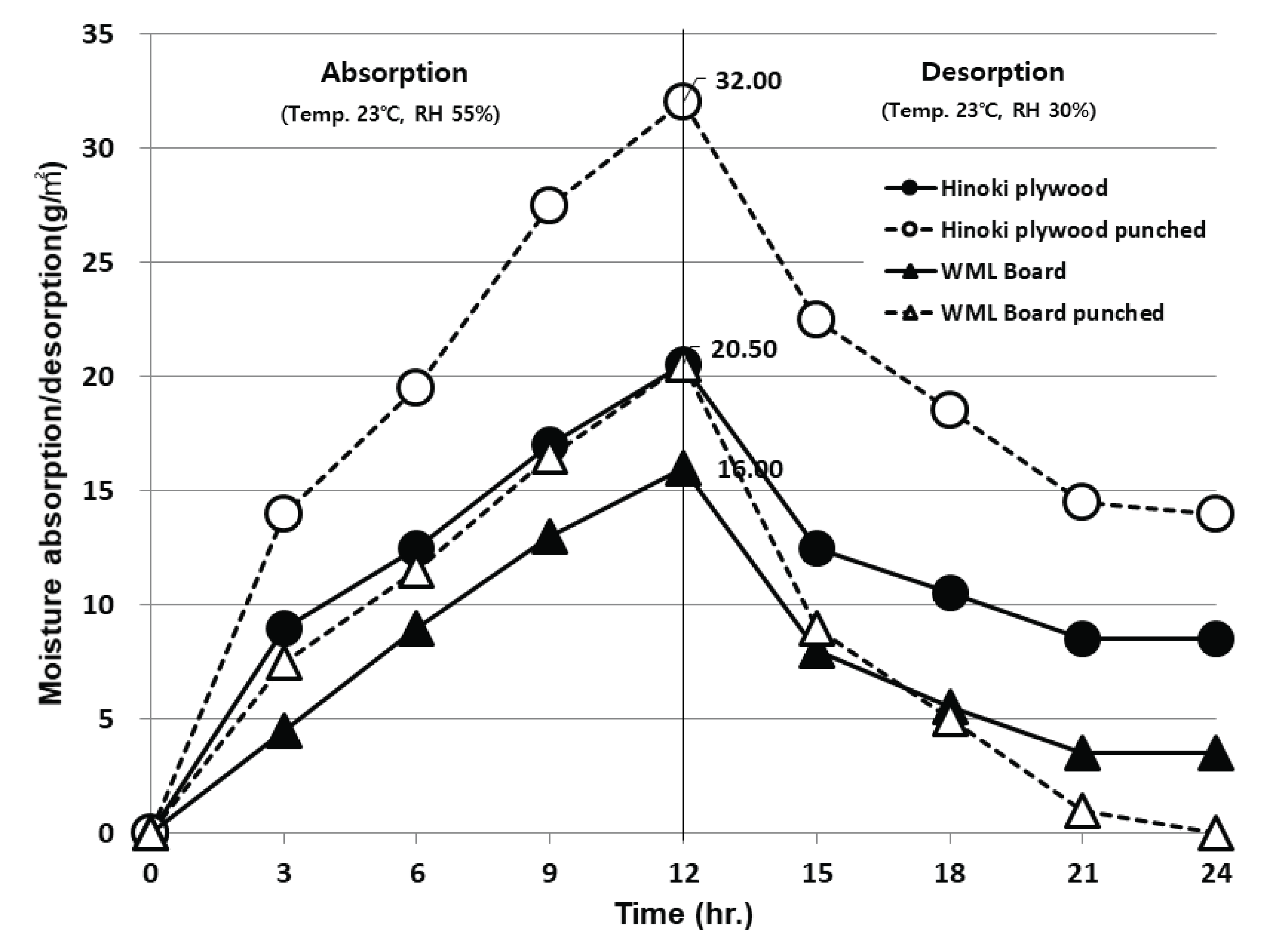
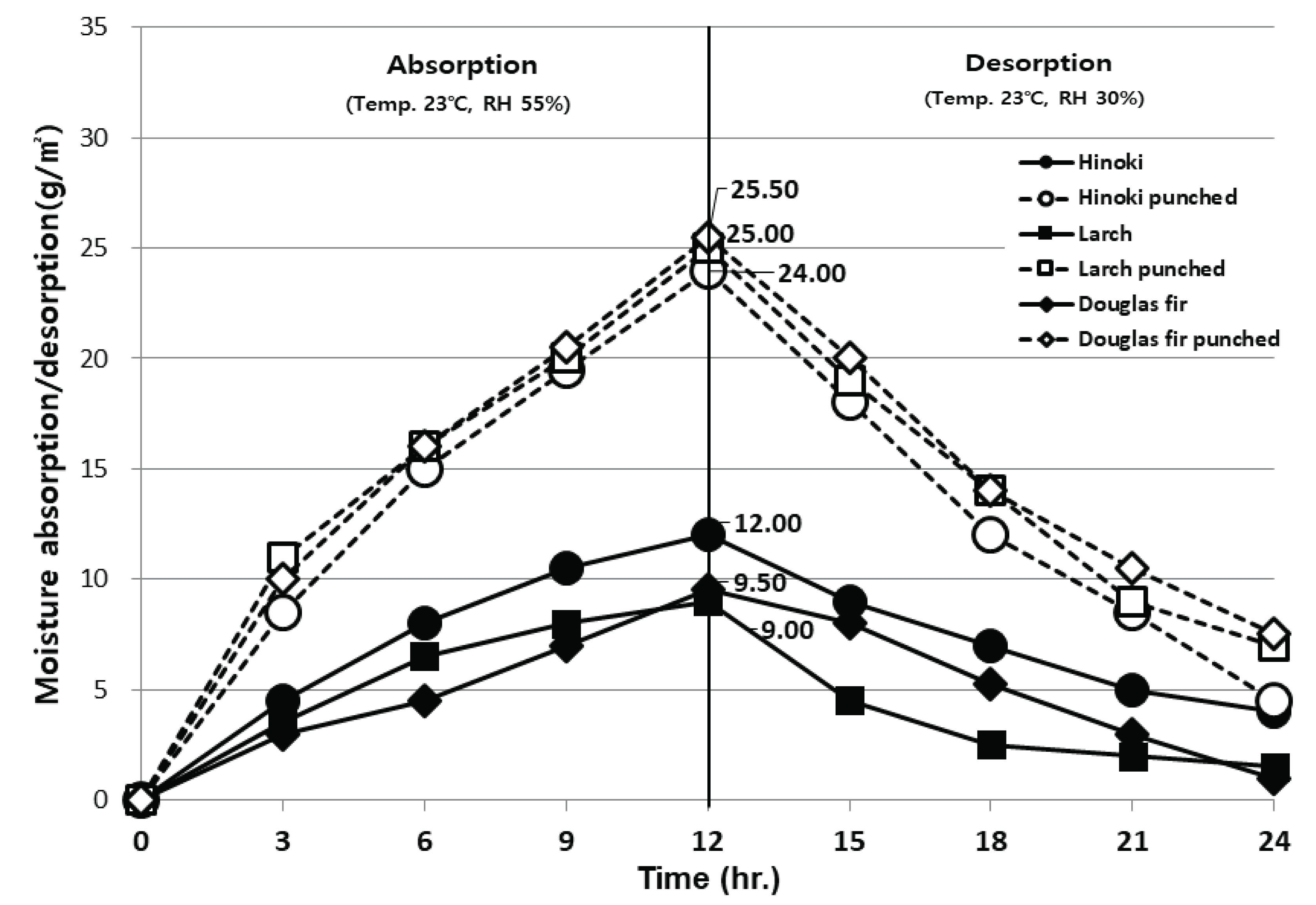
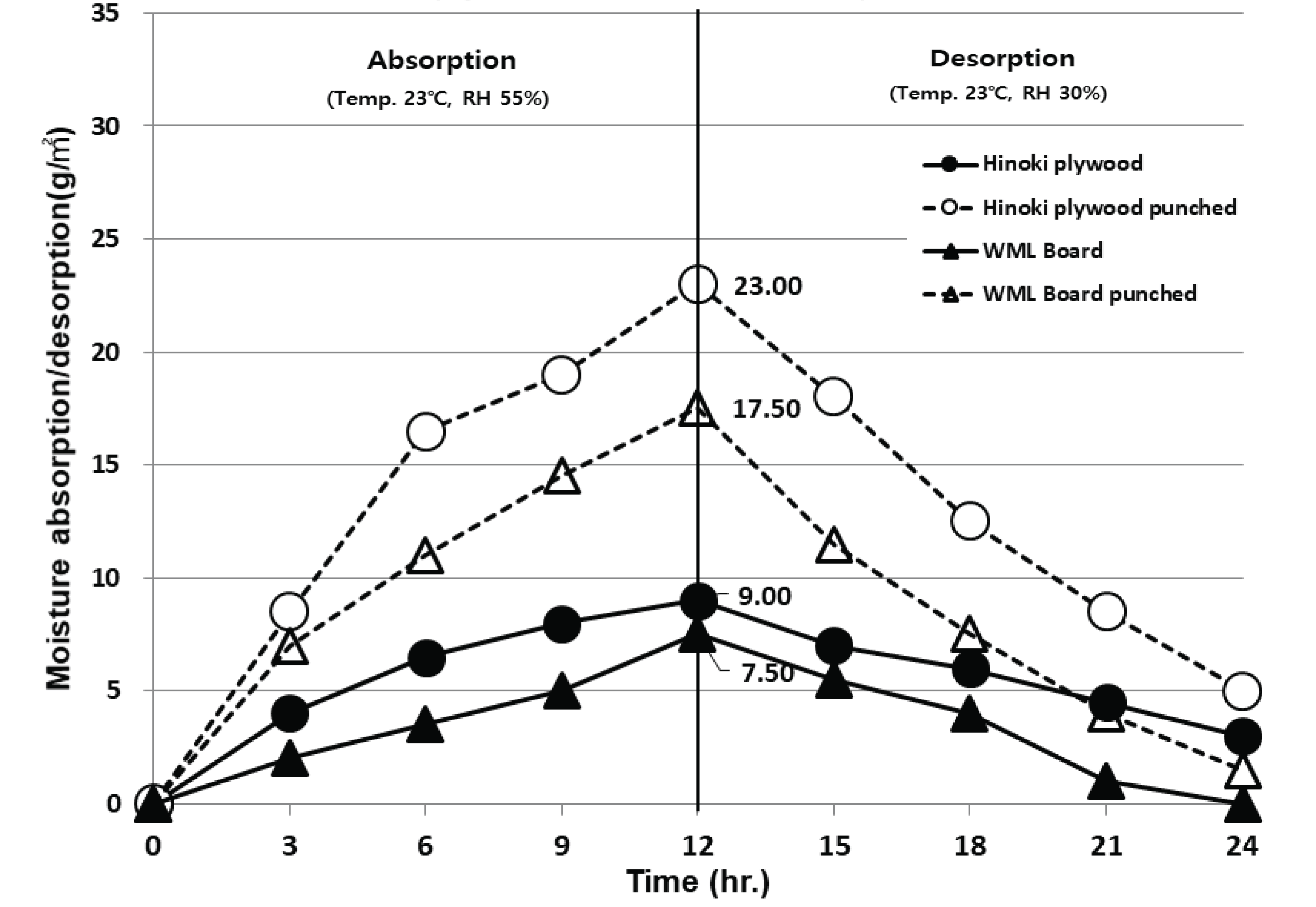
The Health-Friendly Housing Construction Standards stipulate that the performance of building materials should be evaluated according to the KS F 2611, and that building materials with the amount of moisture absorbed and desorbed not less than 65g/m2 on average should be used (Ministry of Land, Infrastructure and Transport. 2019).
As for changes in the amounts of moisture absorbed and desorbed over time, as can be seen in the tables and figures, all materials identically showed a tendency to increase moisture absorption and desorption continuously over 12 hours of the moisture absorption process and 12 hours of the moisture desorption process. The punched materials showed steeper slopes in the graphs compared to the materials with no punching (control) in both the moisture absorption process and the moisture desorption process and the materials with no punching (control) showed gentler slopes and slopes close to horizontal when 9-12 hours passed in the processes. Given the slopes of the punched materials, it can be predicted that the amount of moisture absorbed and desorbed will continuously increase over time in the moisture absorption and desorption processes. The experimental results are judged to be attributable to the fact that punching increased the surface areas of the materials compared to wood and wood-based materials with no treatment and the larger surface areas were effective for moisture absorption and desorption. When 9-12 hours passed in the moisture absorption process, the wood and wood-based materials with no finishing or punching (control) showed an absorption rate (g/m2·h) of 1.0 g/ m2·h, while the material with no finishing but with punching showed an absorption rate of 1.3 g/m2·h on average, indicating that the absorption rate increased by about 30% when the materials were punched. In addition, materials with stain finishing and no punching (control) showed an absorption rate of 0.57 g/m2·h on average, while materials with stain finishing and punching showed an absorption rate of 1.43g/m2·h on average, indicating that the absorption rate increased by about 151% (1.43 g/m2·h to 0.57 g/m2·h) when the materials were punched. From the results described above, it can be predicted that in the case of punched materials, the amount of moisture absorbed will keep increasing over time even after 12 hours have passed. On the other hand, among stain finished materials, Douglas fir and WML Board showed an absorption rate of 0.83 g/m2·h at the maximum when 9-12 hours passed, while larch and hinoki plywood showed an absorption rate of 0.33 g/m2·h, indicating sharp decreases in absorption rates (Table 3, Table 4).
After moisture desorption for 12 hours, the residual weight of moisture of WML Board with no surface finishing was shown to be 3.5 g/m2 in the control and 0.0 g/m2 in the punched samples (Table 3). In addition, the residual weight of moisture of WML Board with surface finishing was shown to be 0.0 g/m2 in the control and 1.5 g/m2 in the punched samples. The foregoing indicated that the moisture absorption property of the magnesium board used in the core of WML Boards was lower compared to the wood and plywood compared in this study and the relatively smaller amount of moisture absorption is judged as indicating that the absorbed moisture was almost completely released during the moisture desorption process for 12 hours.
As shown in Tables 3 and 4 and Figs. 1, 2, and 3, in the case of the wood and wood-based materials tested in this study, moisture absorption can be predicted to continue even when 12 hours have passed. However, the results in this study differed from the results in a study conducted by Lee et al. (2016) in which the absorption rate of carbonized MDF and carbonized PB reached 0 g/m2·h when 9 hours passed. This can be attributed to the fact that in the case of the wood and wood-based materials used in this study, the tissues were maintained more densely so that moisture absorption and desorption rates were lower and moisture absorption and desorption progressed for longer periods of time. The desorption rates (g/m2·h) showed a tendency to gradually decrease over time in all materials, and identically to absorption rates, desorption rates were shown to be higher in punched materials and materials with no stain finishing. In larch, hinoki plywood, and WML boards without punching, desorption rates showed a tendency to reach 0g/m2·h when 9 hours passed (Figs. 1 and 2).
Consequently, in all the materials tested in this study, moisture absorption and desorption properties showed a tendency to greatly increase when ∅4 mm diameter holes were punched at intervals of 20 mm, and in particular, even when the surfaces of the materials were painted with 100g/m2 of Crack Seal Wood water-repellent stain, it was identified that the amount of moisture absorbed increased by at least two times in all wood and wood-based materials, that is, by 277% (larch, 25 g/m2 compared to 9.0 g/m2) at the maximum, and by 200% (hinoki, 24 g/m2 compared to 12.0 g/m2) at the minimum (Figs. 3 and 4). It could be identified that moisture desorption rates and the amounts of moisture desorbed also showed a tendency to increase rapidly and greatly when the materials were punched compared to when not punched (Figs. 1 and 2), and that the effects of punching were larger when the surfaces were stain finished (Figs. 3 and 4). In particular, when wood and wood-based materials are applied as interior finishing materials, the surfaces are usually painted to prevent contamination, improve beauty, and provide functionality. It can be seen that such paint finishing dramatically reduces the moisture absorption and desorption properties of the materials (Figs. 3 and 4).
To develop moisture absorption/desorption functional building materials that satisfy the amount of moisture absorbed/desorbed of at least 65 g/m2 on average given in the Health-Friendly Housing Construction Standards and the amount of moisture absorbed/ desorbed of at least 85 g/m2 on average given in the national Green Technology under the Act on Low Carbon Green Growth, wood of three tree species and two types of wood-based materials were tested, and the results are as shown in Table 5 and Figs. 5, 6, and 7. The amounts of moisture absorbed/desorbed/ averages of the tested materials were evaluated and according to the results, the largest amounts of moisture absorbed/desorbed were shown by non-finished/ punched hinoki plywood (amount of moisture absorbed 32.00 g/m2/amount of moisture desorbed 18.00 g/m2/average 25.00 g/m2) followed by non-finished/ punched hinoki wood (amount of moisture absorbed 29.50 g/m2/amount of moisture desorbed 20.00 g/m2/average 24.75 g/m2) and the smallest amounts of moisture absorbed/desorbed were shown by stain finished/ non-punched (control) hinoki plywood (amount of moisture absorbed 9.00 g/m2/amount of moisture desorbed 6.00 g/m2/average 7.50 g/m2) and WML Board (amount of moisture absorbed 7.50 g/m2/amount of moisture desorbed 7.50 g/m2/average 7.50 g/m2), thereby showing differences between the tested materials reaching about 333% at the maximum (Table 5).
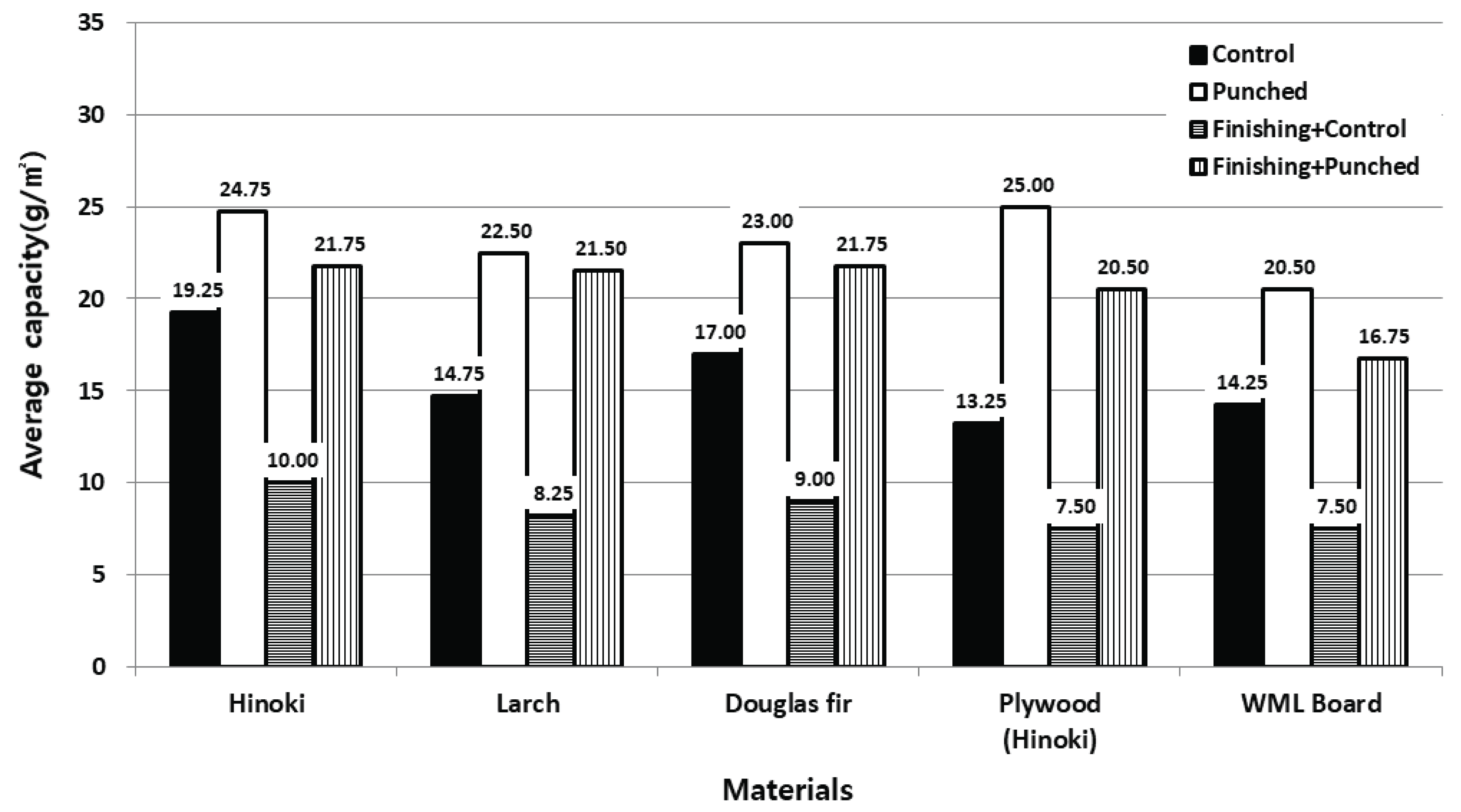
As shown in Table 5 and Figs. 5 and 6, differences between the amounts of moisture absorbed and desorbed were shown to be the largest in non-finished/ punched hinoki plywood at 14.00 g/m2, and smallest in non-finished/punched WML boards and stain finished/ non-punched (control) WML boards at 0.00 g/ m2. The desorption in Table 5 is the values obtained by deducting the residual weight after a moisture desorption process for 12 hours from the amounts of moisture absorption after moisture absorption for 12 hours shown in Tables 3 and 4. The values indicate absolute amounts of moisture desorption.
(Ex. : Hinoki, Non-Finished Control, Desorption = 23.00 g/m2 - 7.50 g/m2 = 15.50 g/m2)
Overall, the amounts of moisture absorbed for 12 hours were shown to be larger than the amounts of moisture desorbed for 12 hours, and the amounts of moisture absorbed were shown to be at least 25 g/m2 in the case of non-finished/punched wood and plywood, while they were not larger than 10 g/m2 in the case of stain finished/non-punched (control) materials, indicating that moisture absorption capacity can differ between painted and non-painted materials by more than two times. Wood finishing materials are usually finished with paint to protect the wood from moisture or water and improve dimensional stability. The filmforming finishes slow down both the absorption of water vapor and drying of the wood, and similarly to a study indicating that alkyd paint could prevent 80% of the absorption of water vapor compared to cases where no painting was applied (Williams et al., 1996), finishing with paint was shown to be effective in blocking moisture absorption and desorption. However, finishing with paint adversely affects the performance condition of functional building materials that must absorb and desorb at least 65g/m2 of moisture for 12 hours under the conditions of a certain temperature (23 °C) and humidity (30% RH → 55% RH), indicating that processing is required to meet the performance standards for functional building materials. Therefore, in order to see the effects of improved moisture absorption and desorption properties when materials are painted, ∅4mm diameter holes were punched at intervals of 20 mm, as shown in Table 1. As a result, as can be seen in Table 6, the average amounts of moisture absorbed and desorbed increased by 29% at the minimum in hinoki and by 89% at the maximum in hinoki plywood because of the increases in the areas for moisture absorption and desorption thanks to the punched holes. The reason why the highest value was shown in hinoki plywood is judged to be the fact that the 18 mm thick hinoki plywood was thicker compared to other materials, so that the surface area after punching, which was 302.87cm2, was wider than the other materials (235 cm2~285 cm2). Consequently, punching holes in the surface of wood and wood-based material was judged to be a method to improve moisture absorption and desorption properties regardless of whether the materials are painted or not.
In cases where the surface areas were the same, the effects of punching were shown to be greatest with larch, followed by Douglas fir and hinoki, in order of precedence. The foregoing results are attributable to the anatomical properties inherent to the materials, which are similar to the water diffusion coefficients of wood, of which the water diffusion coefficient in the radial direction is known to be 1.0~1.2 times higher than that in the tangential direction, and that in the fiber direction is known to be 45~600 times higher than that in the direction perpendicular to fibers (Lee et al., 1992), and it is judged that in the case of tree species for which water diffusion is more difficult, moisture absorption and desorption properties can be improved by increasing the cross-sectional area of wood by punching, etc.
Although wood and wood-based materials are generally known to have excellent humidity control (humidity control performance), according to the results of this study, the humidity control performance does not meet the test conditions (Table 2) and performance standards (the amounts of moisture absorbed and desorbed not less than 65 g/m2 on average) given in the Health-friendly Housing Construction Standard.
Recently, regulations and laws for building finishing materials have been strengthened in relation to safety and environmental issues. Accordingly, Fig. 8 shows the reality where the application of materials becomes difficult when the quantitative and objective certified test reports or related certifications for the materials used are not obtained.
Therefore, although wood and wood based materials are widely known as materials that are friendly to humans and environments, more concrete and scientific reviews and further studies are judged to be necessary for diverse applications of materials as eco-friendly healthy materials and functional materials.
4. CONCLUSION
This was a basic study to evaluate the wood of three tree species (Douglas fir, hinoki, and larch) and two types of wood-based materials (plywood and WML Board) to see whether the materials can meet the moisture absorption/desorption properties required for functional building materials given under the Health- Friendly Housing Construction Standards, check the applicability of the relevant materials as functional finishing materials, and improve the performance of the materials. The results of this study are as follows.
All five types of wood and wood-based materials tested were evaluated to have moisture absorption/ desorption properties that do not satisfy the amount of moisture absorption/desorption of at least 65 g/m2, which is the performance standard for moisture absorption/desorption functional building materials, indicating that untreated wood and wood-based materials cannot be applied as the functional finishing materials given by the Health-Friendly Housing Construction Standards.
Surface stain finishing led to dramatic decreases in moisture absorption/desorption rates as well as reductions in the amounts of moisture absorbed and desorbed by at least two times on average.
It was shown that when ∅4mm diameter holes were punched in the surfaces of the materials at 20 mm intervals, the areas for moisture absorption/desorption increased from 18% to 51%, and this increase was shown to be capable of increasing the amounts of moisture absorbed/desorbed by 29% on average at the minimum and 81% on average at the maximum. The effects of punching were shown to be identical even in cases where the materials were stain finished.
Although wood and wood based materials are widely known as materials that are friendly to humans and environments, more concrete and scientific reviews and further studies are judged to be necessary for diverse applications of materials as eco-friendly healthy materials and functional materials.









